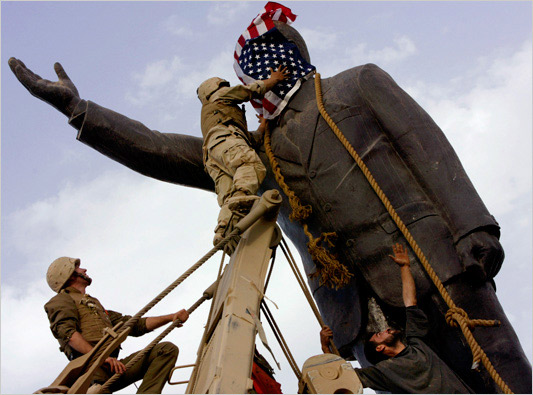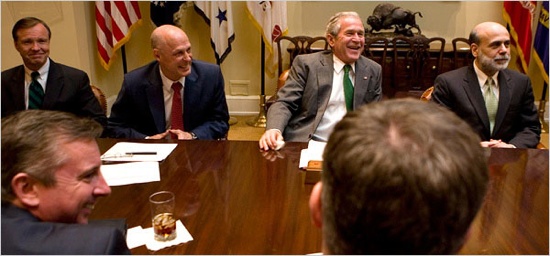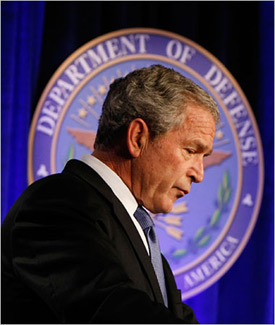Notes
Saving Face

For it’s coverage of the fifth anniversary of the Iraq War, the NYT is using the platform of its new Baghdad Bureau blog to highlight key images and recollections.
In this instance, The Times paired this highly controversial image with a vignette from the soldier who lent his flag for this act in Firdos Square. In that reflection, then Lieutenant Tim McLaughlin recounts how the U.S. flag that covered the Saddam statue’s face was given to him after the attack on the Pentagon on 9/11.
Writes Mr. McLaughlin, who left the service as a captain in September ’06 and is now a second year law student at Boston College:
On April 9, my tank was the first to roll into Paradise Square in Baghdad. The world’s media were there, too, confined to the Ishtar and Palestine hotels, but I didn’t know that at the time. I was scanning for people who were trying to kill me. Turns out the bad guys were a few blocks to the northeast where my friend Chad’s platoon was. My American flag was placed on the statue of Saddam Hussein that day so I could take a picture of it. People watching on their televisions at home saw it too.
They liked it. Or didn’t. Or changed their minds later on. I told a reporter, “I know Iraq didn’t have anything to do with Sept. 11, but I think that given the opportunity, a person like Saddam Hussein would certainly be capable of trying to hit London or Paris or New York.”
What’s wrong here? Let’s count. In pairing the image with this defensive account, there is the suggestion that:
1. The military condoned the act, when in fact it realized, almost instantly, that the placement of the flag was a symbolic disaster.
2. The military supposedly didn’t know the press would be there!!!
3. Even in retrospect, the act is seen as serving a strictly private purpose.
4. In spite of the disclaimer, Saddam Hussein is still mentioned as a threat in the same breath as 9/11.
What is mostly wrong here, however, is the editorial act of using McLaughlin to run interference for the image. What we see, and need to continue to take away from this visual, is the instinct to conquer. Also not to be obscured is the evidence of the machinery (the outstretched hand of the man from the “rent-a-crowd,” notwithstanding) used by the American military to rip down Saddam’s statue, while simultaneously attributing this act to the popular will.
Maintaining the Times anniversary slant, you can check out more “fast-and-noose” coverage on this companion post.
From 9/11 to Fall of Baghdad, an Ex-Marine Explains What It Means to Him (baghdadbureau.blogs.nytimes)
U.S. Flag on Iraqi Monument Causes Concern (Common Dreams)
History To Some, Coney Island To Others (BNN)
(image: Jerome Delay/AP. Baghdad, 2003. via nytimes.com)


Reactions
Comments Powered by Disqus